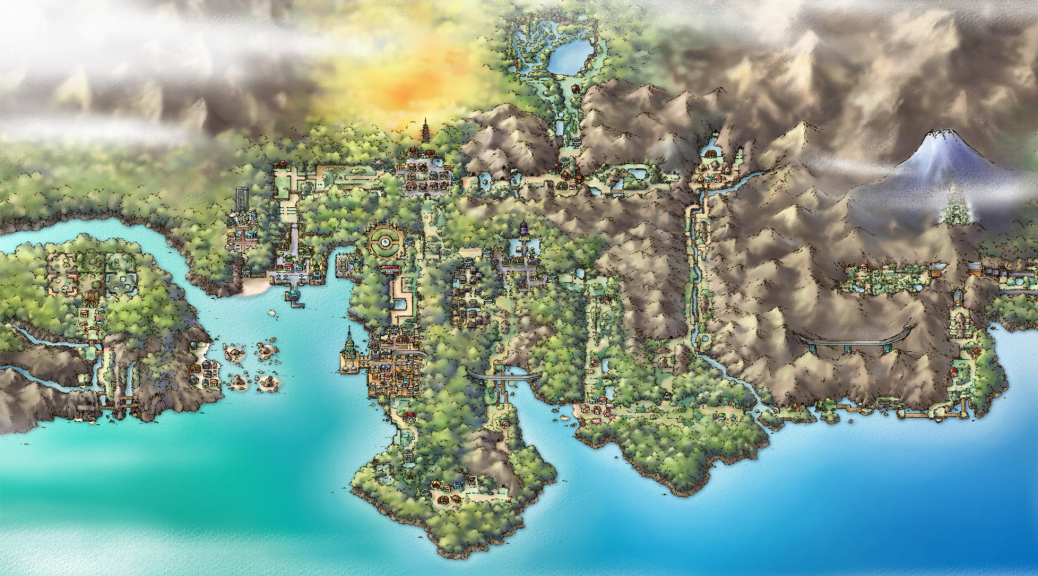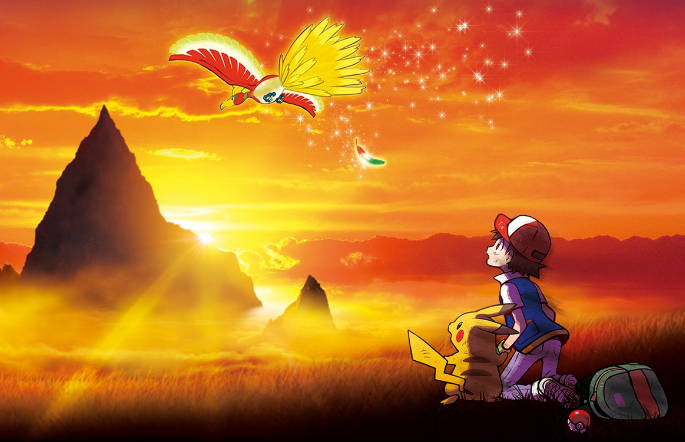In celebration of Pokémon’s 25th anniversary, we are exploring the geographical inspirations behind each Pokémon region in the video games. In this second edition, we are visiting the Johto region, introduced in Pokémon Gold, Silver, and Crystal, along with their remakes HeartGold and SoulSilver. The information in this article comes from Bulbapedia’s fantastic guides to the real world locations that inspired the Pokémon universe.
Geographically, Johto is based on the Kansai region of Japan, just as Kanto is based on the actual Kantō region. Kansai is home to Kyoto, the former capital, and other cities like Osaka, Nara, and Kobe.
Kansai and Kantō are often compared and contrasted, and there has been a rivalry of east and west since the Edo period. The people of Kantō are described as being the centre of standardisation and formalities, contrary to those of Kansai, who are more down-to-earth and good-humoured. The architecture and culture of Johto personifies an older, more diverse region. However, Kanto and Johto are unified by their contradictory but varied cultures, people, and Pokémon.
 The name “Johto” was coined by game designer Junichi Masuda, translating as “castle palace” (城都). This likely references the use of traditional Japanese architecture seen in Johto, as several of the Johto landmarks are based on historic temples.
The name “Johto” was coined by game designer Junichi Masuda, translating as “castle palace” (城都). This likely references the use of traditional Japanese architecture seen in Johto, as several of the Johto landmarks are based on historic temples.
The two primary legendary Pokémon are Ho-Oh and Lugia, a pair of mythical birds. In the games, the people of Johto built the Brass Tower and the Bell Tower in Ecruteak City, which became the roost of Ho-Oh and Lugia. A lightning strike burnt down the Brass Tower, the fire being put out by a sudden rainstorm. Three unnamed Pokémon died in the fire, but Ho-Oh resurrected them as Raikou, Entei, and Suicune, the Legendary Beasts, who personify the three stages of the tower’s fire.
This mythology was inspired by two Buddhist temples in Kyoto called Kinkaku-ji and Ginkaku-ji. Kinkaku-ji is covered in golden leaf, and has a golden phoenix likeness on the roof. Ginkaku-ji likewise has a silver bird on its own roof. In 1950, Kinkaku-ji was burnt down by a schizophrenic monk, then rebuilt in 1955. Another possible inspiration is the Tō-ji and Sai-ji Buddhist temples in Kyoto. Sai-ji was burnt down twice and never rebuilt.
Ho-Oh is based on the Fenghuang, the Chinese phoenix, its very name being the Japanese translation. Lugia may be based on Ryūjin, the Shinto sea god, a dragon that lived on the ocean floor. Raikou, Entei, and Suicune are inspired by mythical beasts: Raikou is based on the Raiju, a thunder demon; Entei is similar to stone lion guardians found across Asia; and Suicune is inspired by the Qilin, a creature said to be able to walk on water.
Connecting Johto and Kanto together is Mount Silver, based on the iconic Mount Fuji. At the end of Gold & Silver, the player will reach the mountain peak and battle Red, the protagonist of Pokémon Red & Blue. This may reference Kuninotokotachi, said to be one of the first Japanese deities, who lived atop Mount Fuji. He is described as being born from a humble reed shoot growing between Heaven and Earth. Similarly, Red rose up from his small town to become the Pokémon League Champion.
Our journey through Johto truly starts in New Bark Town, where we can choose our starter Pokémon: Chikorita, Cyndaquil, or Totodile. The town is based on a combination of Shizuoka and Hamamatsu. The next stop, Cherrygrove City, is a small location where players first battle their rival Silver. Cherrygrove may be based on Toyohashi, famous for flower gardens and festivals.
Violet City is based on Nara, the former capital of Japan between 710 to 795 AD. Violet City’s most recognised landmark is the Sprout Tower, where the sages inside all use Bellsprout. The central pillar sways from side to side, said to have been the body of a gigantic Bellsprout. This is actually based on an architectural safety method called “jūkōzō”, applied to many tall buildings to protect them from earthquakes. Sprout Tower is based on the Kōfuku-ji, a Buddhist temple in Nara. Also present in Violet City is the Pokémon School, a nod to Kōfuku-ji being home to the Japanese branch of East Asian Yogācāra, where certain traditions of Buddhist philosophy are taught.
Azalea Town references Minabe, a quiet, picturesque mountain town. Minabe is known for its high-quality apricots and charcoal, both of which are referenced in Azalea, where “Apricorns” are sold, used to create Pokéballs, and charcoal is a notable business. The Bug-type Gym Leader, Bugsy, may reference Pokémon creator Satoshi Tajiri, and his childhood love for bug-catching. Slowpoke are revered in town, as their yawns cause rainfall, but their tails are considered a delicacy.
Goldenrod City is the biggest metropolis in Johto, home to Gym Leader Whitney and her dreaded Miltank! Goldenrod, based on Osaka, is very similar to Celadon City, complete with a multi-storey department store, a game corner, and the Magnet Train which links to Saffron City in Kanto. The Goldenrod Radio Tower is based on the Tsūtenkaku, a popular tower in Osaka. The National Park, where bug-hunting contests are held, is likely inspired by the Expo Memorial Park. A monument in the historic park is called the Tower of the Sun, which would inspire Volcarona in the fifth generation of games.
Ecruteak City is based on Kyoto, being the location of the Burned Tower and the Bell Tower. Kyoto is considered the last mainstay for the traditions of the Geisha, female entertainers who embody purity and are taught the traditions of the Japanese performing arts. This is represented in the Ecruteak’s dance theatre where trainers can fight the Kimono Girls.
Olivine City is based on Kobe, a major port city. Aside from both being port towns, Olivine references Kobe’s famous beef, and features the Glitter Lighthouse, watched by an Ampharos. Ampharos, though a sheep Pokémon, sports the features of a lighthouse, and the second part of its name “Pharos” is Greek for “lighthouse”.
Across the sea from Olivine is Cianwood City, based on Naruto City, home of the Otsuka Pharmaceutical. This is referenced in Cianwood, through a small, 500-year old pharmacy. The Whirl Islands, located in-between Olivine and Cianwood, are the home of Lugia. They are based on the whirlpools found in the Naruto Strait. These whirlpools inspired the name of Naruto Uzumaki, titular character of Naruto, who gets a bridge named after him in his manga. In myth, Lugia is said to have split one of the Whirl Islands apart to end a war; a nod to the Great Hanshin earthquake, the epicentre being in the Naruto area.
Mahogany Town is based on Kōka, best known for its history associated with ninjas. Strangely, Mahogany’s Gym Leader Pryce specialises in Ice-types. Mount Mortar, to the west of Mahogany, is based on Mount Hiei, where “marathon monks” endure long walks to achieve enlightenment. In the games, players meet Kiyo, the Saffron City Karate Master, who trains in deep isolation within Mount Mortar.
North of Mahogany Town is the Lake of Rage, where the first shiny Pokémon, a red Gyarados, can be caught. It is inspired by Japan’s largest lake, Lake Biwa. The Ice Path, a mountainous frozen cave, is based on two locations. One is Mount Ibuki, known for having the heaviest snowfall in recorded history, at nearly twelve metres on the peak. The second references several caves in Aokigahara Forest, which are frozen all year round.
Our final destinations are Blackthorn City and the Dragon’s Den. Blackthorn City is home to a Dragon-type Gym. It is based on the city Kai, originally named Ryūō, a small town whose name means “Dragon King”. In 2004, the town was fused with Futaba and Shikishima into Kai. The Dragon’s Den is supposedly based on the Kanazakura Shrine, located in Kofu, home to five sacred crystals, guarded by two decorative dragons. There is a small shrine within the Dragon’s Den where the player is quizzed on their relationship with their Pokémon.
Join us in our next article, where we travel to the Hoenn region, the setting for Pokémon Ruby, Sapphire, and Emerald.
What is your favourite location in the Johto region? Which is your favourite second generation Pokémon? Leave a comment below, or on our Twitter feed!

